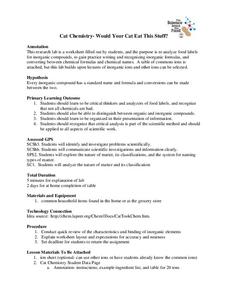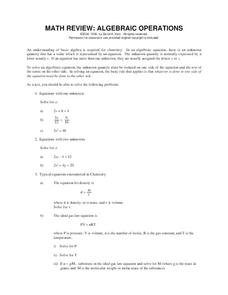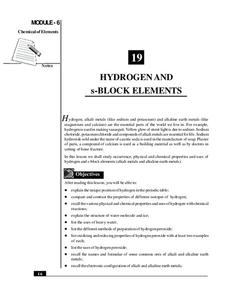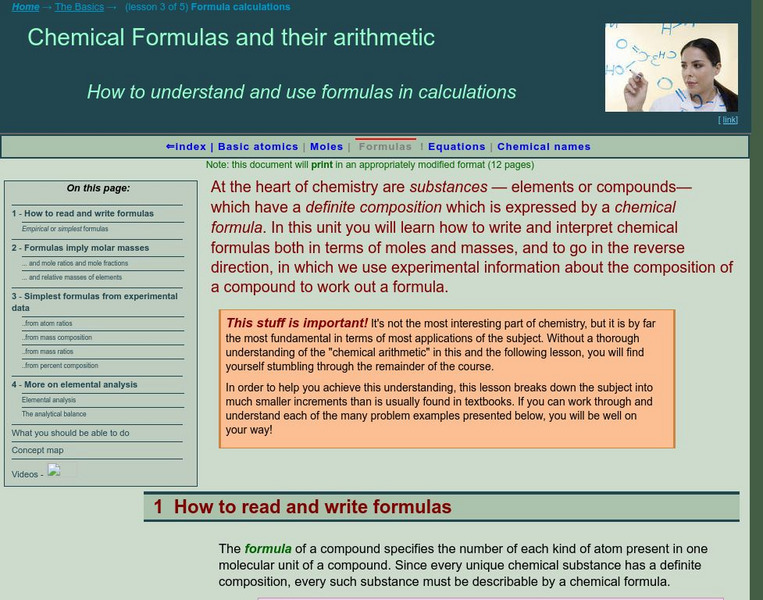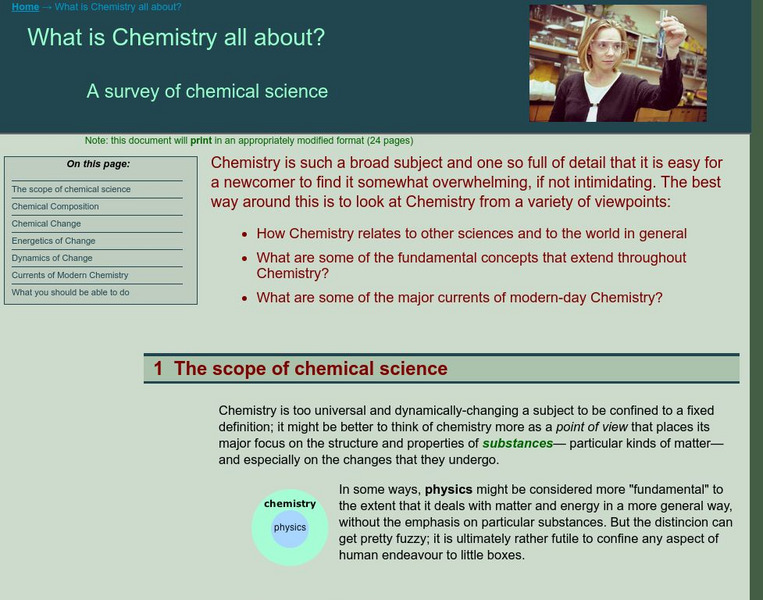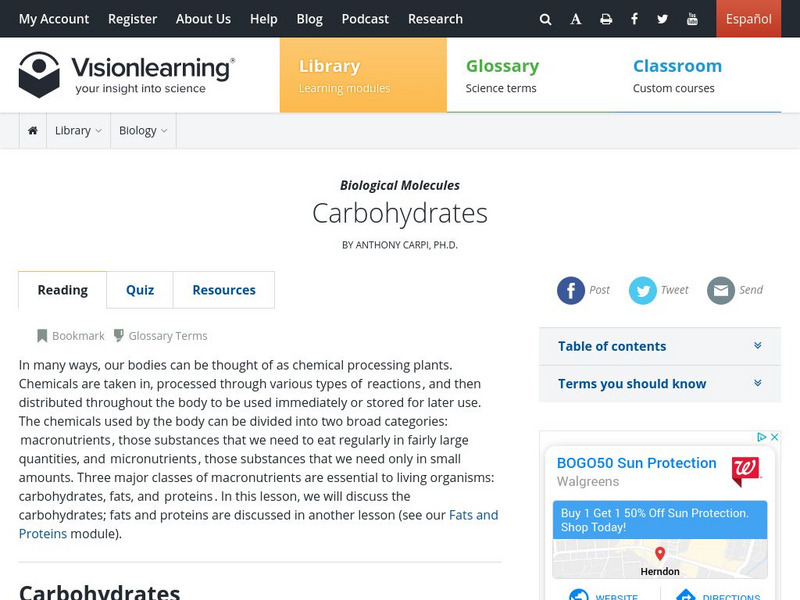National Institute of Open Schooling
Chemical Arithmetics
Substances with the same empirical and molecular formula must be differentiated by their structural formula. Part two in a series of 36 has pupils using chemical formulas to calculate how much of a compound is present in a given...
It's About Time
Chemical Names and Formulas
Abracadabra! Provide your class with the tools to perform a chemical "magic show" as they predict the charges of various ions, determine ionic compound formulas, and make observations to determine when a chemical reaction between...
University of Georgia
Would Your Cat Eat This Stuff?
Processed foods use inorganic compounds for flavoring and preservation. This take-home laboratory challenges scholars to find 20 different compounds identified on the labels of foods to list on their data collection sheet. The activity...
It's About Time
Elements and Compounds
Young scientists use electrolysis to separate water into its elements before experimenting with fire to learn about their properties. A helpful resource provides a reading passage and analysis questions.
Curated OER
Math Review: Algebraic Operations
Need to prep your science learners in math? Here is a resource that serves as a review guide to support your scientists with the math they need to be successful in chemistry. Comes with basic algebraic problems and a review of...
American Chemical Society
Development of Baking Powder
Did you know baking powder can be used to treat acne, whiten teeth, and make sugar cookies? The lesson on the development of baking powder is ready-to-go with no preparation required. Through readings, pupils answer questions, complete...
National Institute of Open Schooling
Hydrogen and s-Block Elements
Lesson 19 in the series of 36 analyzes the element hydrogen and the s-block elements. Through readings, answering questions, and discussion, learners write about and explain their occurrence, physical and chemical properties, and...
It's About Time
Organic Substances
Host an exciting lab in which learners burn fruit rinds to better understand hydrocarbons. A reading passage and analysis questions wrap up the lesson.
National Institute of Open Schooling
p-Block Elements and Their Compounds – II
Ozone, made of three bonded oxygen atoms, is found 15-30 km above Earth, has a strong smell, is blue, and blocks sunlight from hitting the surface of Earth. The 22nd lesson in a series of 36 specifically focuses on the important elements...
CPO Science
Potential and Kinetic Energy
Here's a resource ideal for independent learners who need extra reinforcement or would like to work ahead. These textbook chapters and practice problems cover many basic physics concepts, starting with potential and kinetic energy and...
National Institute of Open Schooling
Occurrence and Extraction of Metals
Steel is a man-made alloy or a mixture of metals. Lesson 18 in this series of 36 focuses on metals and their extraction from Earth. Individuals read about, discuss, and answer questions after learning how people find most metals, the...
Simon Fraser University
Chem1 Virtual Textbook: Working With Formulas
As part of the "Basic Atomics" section of the Virtual Textbook, this site examines formulas and how they are read and written. Other topics covered include a concept map, simplest formulas, and masses.
eSchool Today
E School Today: Elements, Compounds, Substances and Mixtures
Learn about the classification of matter based on whether the chemical composition is pure or a mixture. Understand the definitions of elements, compounds, substances, and mixtures, and what the differences are between them. Five types...
Science Struck
Science Struck: Baking Soda: Chemical Formula, Preparation, and Uses
Baking soda has a variety of uses, including for household cleaning and for baking. Read about its chemical formula and its common reactions.
Simon Fraser University
Chem1 Virtual Textbook: Simplest Formulas From Experimental Data
As part of the "Basic Atomics" section of the Virtual Textbook, this site a variety of topics related to simplest formulas including simplest formulas from atom ratios, simplest formulas from mass composition, and more.
Simon Fraser University
Chem1 Virtual Textbook: Energetics of Chemical Change
Energetics of chemical change is a section of a larger overview on Chemistry, which covers a variety of aspects. This section focuses on energetics and equilibrium, and chemical energetics. Examples, formulas, and pictures are provided.
Science Struck
Science Struck: Structure, Formula, and Properties of Phosphoric Acid
Describes the formula, chemical structure, properties, and uses of phosphoric acid.
Simon Fraser University
Chem1 Virtual Textbook: Dynamics of Chemical Change
Dynamics of chemical change is a section of a larger overview on Chemistry, which covers a variety of aspects. This particular section focuses on kinetics and mechanism, kinetics, and catalysts. Examples, formulas, and pictures are...
Simon Fraser University
Chem1 Virtual Textbook: Chemical Composition
Chemical composition is a section of a larger overview on Chemistry, covering a variety of aspects. This section focuses on elements, atoms, compounds, and structure. Examples, formulas, and pictures are provided.
Vision Learning
Visionlearning: Biological Molecules: Carbohydrates
An explanation of why carbohydrates are important nutrients for the human body. Chemical formulas and structures are used to demonstrate simple and complex carbohydrates.
Purdue University
Purdue: Structural Isomers
Definition of structural isomers. Discusses differences in atoms and formulas. Includes differences about chemical and physical properties. Links to related definitions provided.
Other
Aerobic Respiration (Glycolysis)
A very technical explanation of aerobic respiration. The process is explained and supplemented with a number of chemical formulas. Geared to the advanced student.
University of Hamburg
University of Hamburg: Sugars, Carbs, Monosaccharides
Description of the chemical makeup of monosaccharides, accompanied by molecular diagrams of glucose, galactose, and fructose. Links to more in depth information.
Science Struck
Science Struck: The 13 Types of Energy and Their Applications
Read about all the different kinds of potential and kinetic energy. Includes energy formulas and examples of energy applications.
Other popular searches
- Writing Chemical Formulas
- Naming Chemical Formulas
- Ionic Chemical Formulas
- Balancing Chemical Formulas
- Balanced Chemical Formulas
- Wrriting Chemical Formulas
- Chemical Formulas Worksheets


